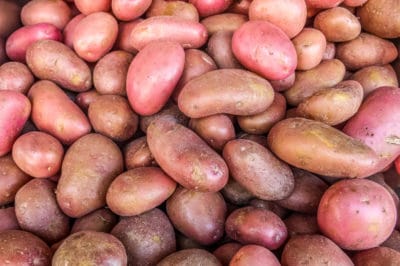Preparing the Soil
Potatoes need loose, friable soil to prevent knobby, misshapen tubers. For red potatoes, that’s even more important as they have thin skins. Heavy feeders, they need plenty of organic humus that’s high in potassium and nitrogen. If you have sandy loam, that’s perfect for potatoes, although you might still want to add some well-rotted leaves or aged manure. Work the soil well prior to planting.
Choosing Varieties
All of the potatoes listed below have light to dark red skins and white interiors:
- Chieftain – widely adapted, resistant to several diseases.
- La Rouge – deep eyes and irregular tubers, but high yield and good for boiling.
- Norland – excellent for boiling and baking; good tuber shape.
- Sangre – large tubers, good for baking and boiling.
- Viking – good culinary quality; drought resistant.
Preparing the Seed Potatoes
It’s usually best to buy certified seed potatoes unless you can be sure you have no disease in your home-grown stock. Small red potatoes – the size of a small hen’s egg or less – should be planted whole. Larger potatoes should be cut in thirds or quarters each with at least two eyes. Cut the potatoes and let them cure for two or three days before planting.
Planting Red Potatoes
Plant your potatoes in trenches that are about six to eight inches deep. Place cut chunks with the cut side down. Space them at least 12 inches apart in 2-foot rows – intensive gardeners can plant them equidistant at 12-inch intervals. Cover with six to eight inches of soil. Hill the plants at least twice during the growing season. Keep plants well-watered.
Harvesting Red Potatoes
Red potatoes will produce “new” potatoes about three weeks after they flower. These tender, tasty spuds are one of the delights of growing your own. Carefully dig down beside the plants and remove tubers the size of a hen’s egg or larger. When the plants start to wilt, stop watering. Harvest the main crop three or four weeks later.
Storing Red Potatoes
Red potatoes have thinner skins than russets. This makes them more susceptible to bruising and damage during harvest. Handle them carefully and eat any that have nicks or cuts within a few days. Cure the potatoes in a warm dry area out of the sun for three or four days. Store potatoes in a cool, dark environment with high humidity. Check weekly for mold or rot.
